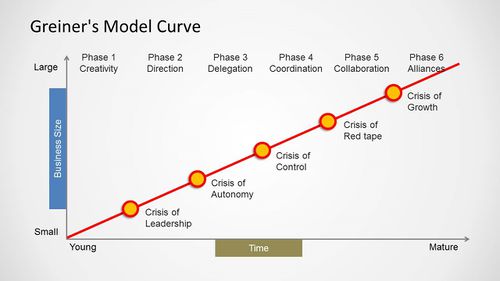The Greiner Curve
Greiner's Growth Model aka The Greinere Curve describes phases that organizations go through as they grow. All kinds of organizations from design shops to manufacturers, construction companies to professional service firms experience these. Each growth phase is made up of a period of relatively stable growth, followed by a "crisis" when major organizational change is needed if the company is to carry on growing. Larry E. Greiner originally proposed this model in 1972 with five phases of growth. In 1998, he added a sixth phase in an updated version of his original article. The six growth phases are described below:
- Phase 1: Growth through creativity: An entrepreneur is focused on creating new products and services. A small staff can be managed through informal communication and a shared vision. But as the firm grows, there is often a leadership crisis with the need to bring in professional management.
- Phase 2: Growth through direction: With new management in place, growth continues. There is more clarity on what the objectives are. Budgets introduced, functions are more clearly defined, incentive schemes are established. This may result in a crisis of autonomy, with a need to define clearer structures and hierarchies to delegate tasks.
- Phase 3: Growth through delegation: As mid level managers are freed up to pursue opportunities in their markets and improvements in their functions, growth continues. To management takes on more of a broad strategic role. The result is often a crisis of control: Managers whose directive approach was helpful at the end of Phase 1 find it hard to “let go.” A more sophisticated approach is needed to make sure the different parts of the organization work well together.
- Phase 4: Growth through coordination and monitoring: Growth continues through better coordination, e.g. organizing previously independent groups along product or service lines. Ultimately, however, the complexity of the company’s bureaucracy creates a red-tape crisis.
- Phase 5: Growth through collaboration: The formal control structure is relaxed to accommodate more flexibility for staff to group along the lines of specific projects or initiatives. Sophisticated information system support this new approach. This phase may well end with a crisis of internal growth, recognizing that opportunities may have to be pursued outside the firm.
- Phase 6: Growth through alliances: This phase was added by Greiner later on, to recognize the fact that at some point, firms may need to pursue growth opportunities through alliances, mergers & acquisitions, outsourcing, or other partnerships.[1]

source: Paul Petrone
See Also
Organizational Change
Organizational Change Management (OCM)
Organizational Development
Change Management
Lewin/Schein's Change Theory
References
- ↑ Defining Grenier's Growth Model and the six phases of growth Vlad Daniloff
